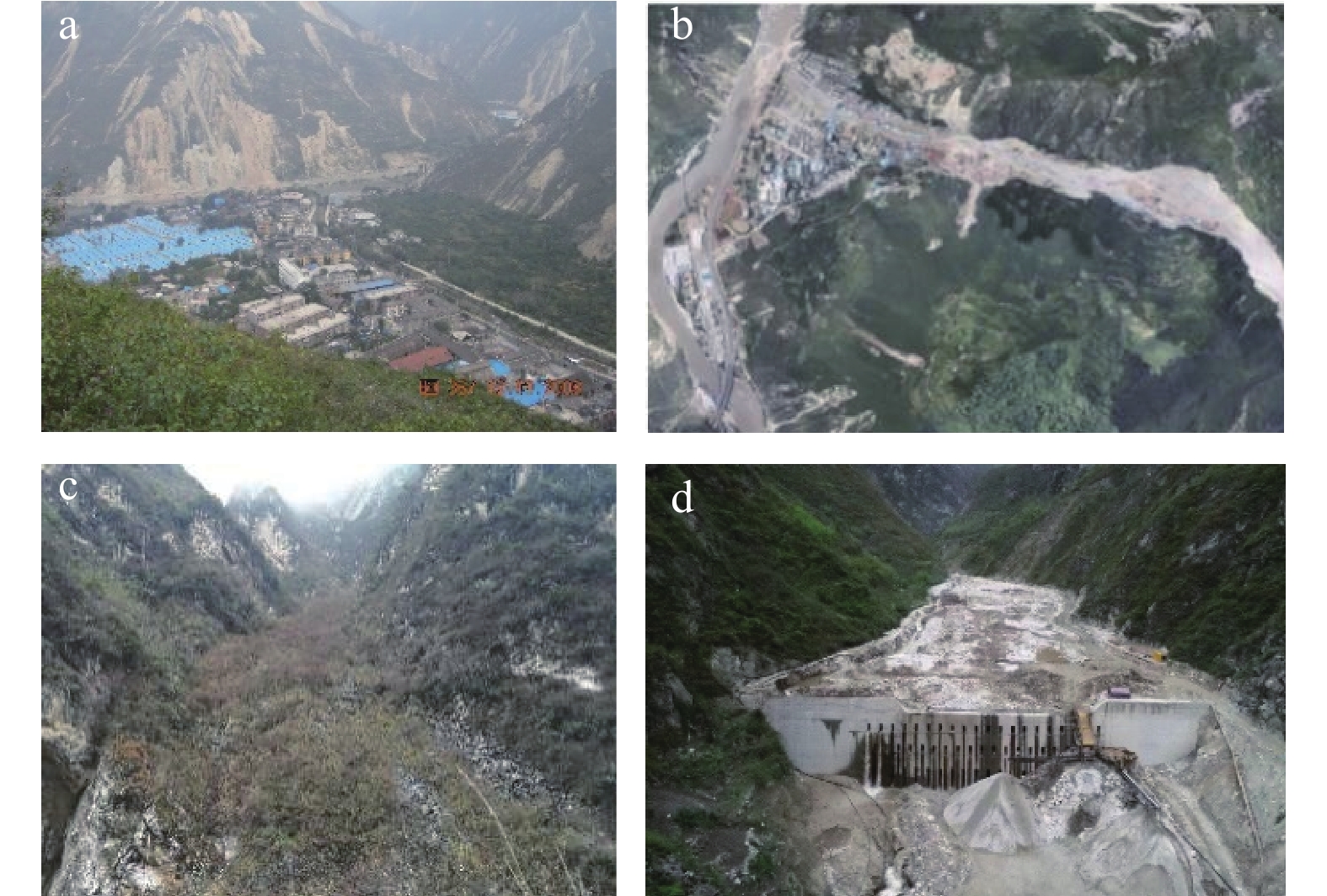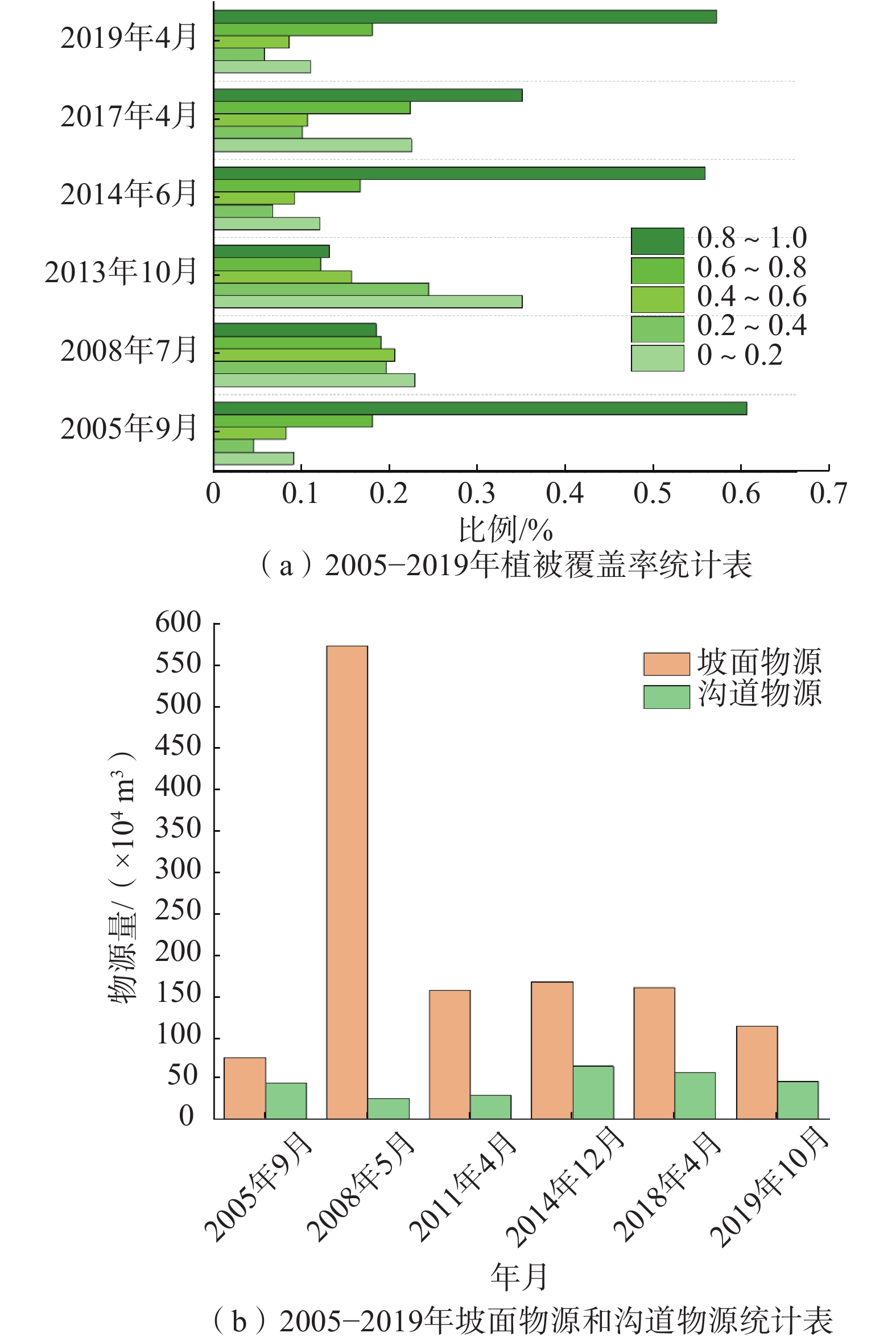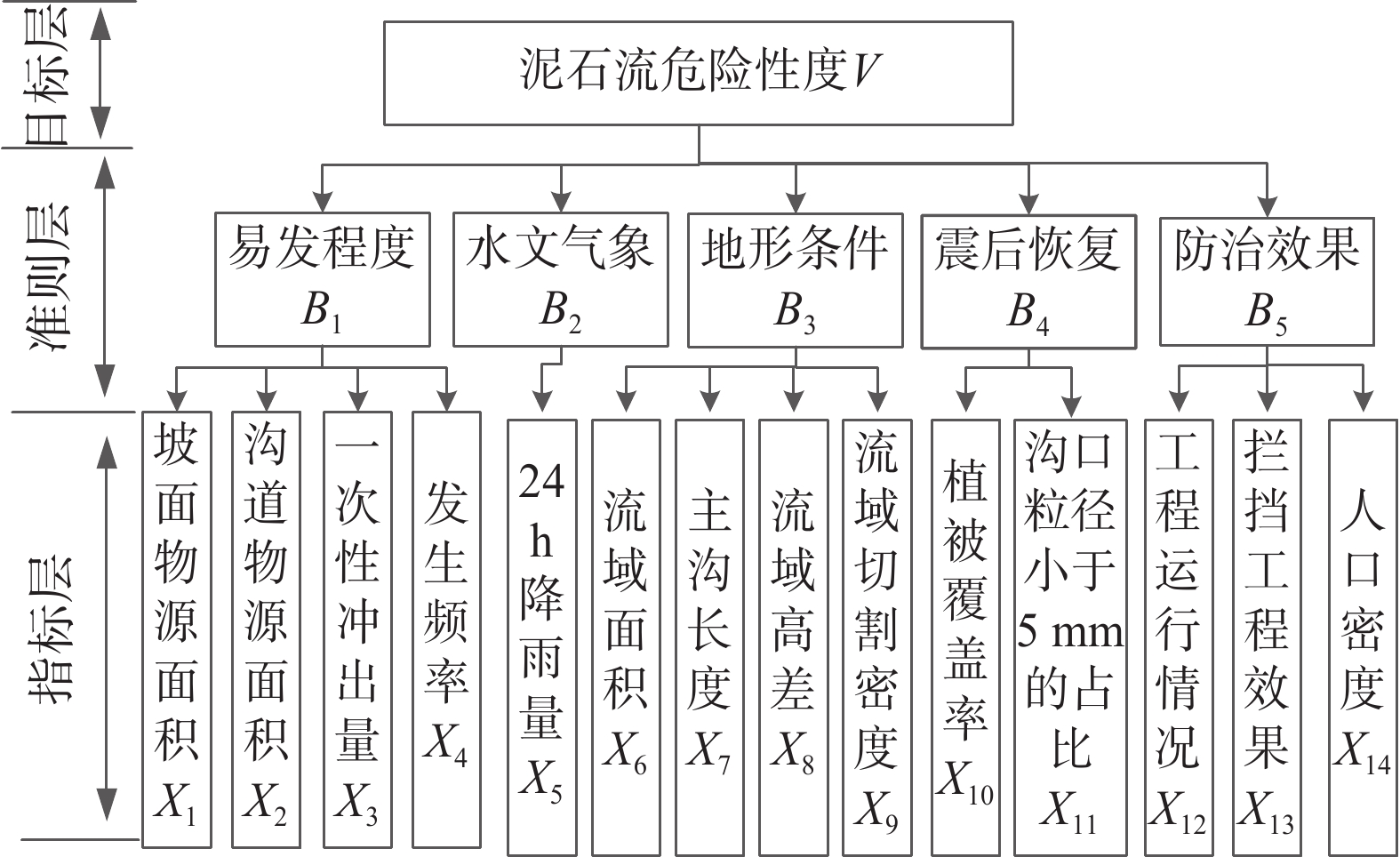Risk assessment of single gully debris flows based on dynamic changes of provenance in the Wenchuan earthquake zone: A case study of Qipan gully
-
摘要:
“5•12”汶川特大地震后,震区山体表面产生大量碎屑物,植被遭到严重破坏,为泥石流暴发提供了极为丰富的物质来源,大大增加了泥石流的危险性。多年来,研究人员针对震后泥石流危险性的评估主要考虑植被恢复情况,较少考虑泥石流沟道存在大量的动储量物质对危险性评估的重要影响。为此,基于现场勘察资料,以汶川县七盘沟为研究对象,采用多源多尺度监测手段(Landsat系列、Quick-bird与无人机)对震前震后坡面物源与沟道物源进行分析统计,综合利用博弈论组合赋权结合云模型构建泥石流危险性动态评价模型,对2005—2019年泥石流暴发的危险性进行评价。结果表明:震后坡面物源是震前的7.7倍,到2019年坡面物源已基本恢复至震前水平。经相关资料记载震后泥石流暴发冲出量及清淤工程量进行统计估算可知,到2019年泥石流动态物源减少约7.813×106 m3。相对比只考虑坡面物源,分别考虑坡面和沟道物源对危险性评价所取得的结果,更切合现实。所得结果对在日益增加的高烈度山区开展重要工程所遭受的单沟泥石流危险性动态评价提供参考与借鉴作用,有效保护人民的生命和财产安全。
Abstract:Following the catastrophic “5•12” Wenchuan earthquake, extensive debris was deposited on mountain surfaces in the earthquake zone, and significant vegetation damage occurred, providing abundant material for debris flow outbreaks and substantially increasing their risk. Previous studies primarily focused on vegetation recovery when assessing post-earthquake debris flow risks. However, field surveys revealed that large quantities of dynamic storage materials in the gullies significantly impact risk assessments. Based on field survey data, this study uses Qipan gully in Wenchuan County as a research subject and employs multi-source and multi-scale monitoring tools (Landsat series, Quick-bird, and UAVs) to analyze and statistically assess the source materials on slopes and gullies both pre- and post-earthquake. A dynamic risk assessment model for debris flow is constructed using game theory combined with a cloud model, assessing the risk from 2005 to 2019. Findings indicate that post-earthquake slope material sources were 7.7 times those pre-earthquake, and by 2019, with recovery to pre-earthquake levels by 2019. Statistical estimations based on recorded debris flow eruptions and sediment removal volumes show a reduction of approximately 7.813×106 m3 in dynamic material sources by 2019. Assessing both slope and gully material sources yields more realistic results than considering slope sources alone. These results provide references and guidance for dynamic risk assessments of debris flow, impacting major engineering projects in increasingly seismic regions and effectively ensuring the safety of life and property.
-
Keywords:
- Wenchuan earthquake /
- debris flow /
- provenance changes /
- combined weighting method /
- cloud model /
- risk assessment
-
0. 引言
泥石流是中国常见山地灾害之一,在短时间内将大量松散物质沿流域冲刷而下,严重破坏山区城镇基础设施,威胁人民生命财产安全[1 − 2]。我国西南地区由于人地矛盾突出,许多城镇和基础设施被迫建立在峡谷阶地、泥石流沟口或周边区域,长期面临泥石流灾害的潜在威胁[3]。不断深入研究泥石流灾害是我国山地灾害防治工作的重要组成部分,防灾减灾抗灾救灾是人类生存发展的永恒课题。
厘清泥石流性质及规模是评价与防治泥石流灾害的关键依据[4 − 7]。目前泥石流容重及规模的研究方法颇多。泥石流容重的确定方法分为宏观分析、微观分析[7]以及现场试验法。现场试验法是取泥石流原状堆积物加水配置,这种方法仅适用于已经发生的泥石流容重测试,且要有相应的泥石流见证者反复确认,该方法得到的容重精确度较低,误差较大。计算方法主要分为宏观经验分析法、微观经验分析法,宏观经验分析法包括建立基于沟床比降、流域面积等与容重之间的关系[8 − 11]。李炳志等[12]分析了泥石流容重随流量、沟床纵坡的变化情况;黄海等[13 − 14]建立基于水源条件的容重预测方法,后又厘定了最大容重、峰值容重和平均容重对其他泥石流运动参数的影响;韩征等[15]通过对四川山区泥石流沟道调查,建立了流域形态完整系数与容重的统计关系,形成基于流域形态完整系数泥石流容重的指数式计算公式;谢娜等[16]分析甘肃陇南一带典型泥石流特征,认为泥石流容重与其流域形态指数成正相关。微观经验分析法通过微观堆积物粒径百分比,提出基于黏土颗粒比例来估算浆体容重值的计算公式[17 − 18]。总结以上这些常用方法发现,宏观经验分析法仅依靠单因素公式建立关系,其结果具有一定的局限性和单一性;微观经验分析法开展条件较复杂,且需要大量现场试验,成本较高。
规模研究上,泥石流的单次最大冲出量即为泥石流固体物质冲出量[19],可依此数据判断泥石流最大活动规模[20]。计算泥石流规模的方法主要有数值模拟、理论分析和试验结果观测。数值模拟多用于不同设定条件下泥石流规模大小与范围研究,从宏观角度分析沟道特征、降水和物源对规模的影响。徐粒等[21]基于HEC-HMS和FLD-2D模型模拟不同降雨情况下泥石流堆积面积与泥沙冲出量关系;唐泽等[22]运用R.Avaflow模型对红椿沟“8•14”泥石流灾害事件进行模拟并得到与实际结果十分接近的泥石流冲出规模;Zhang等[23]利用Herschel-Bulkley-Papanastasiou模型导入Open FOAM成功应用于爱华流域泥石流规模预测;罗超鹏等[24]运用FLOW-3D对泥石流运动规模进行模拟并分区。数值模拟方法虽能直观的展示结果但通常为宏观上的单一冲出量模拟,设定的边界条件较多,不同软件的模拟结果可能不同,对后续误差分析影响较大。理论分析为结合前人研究成果、以历史泥石流灾害事件为参考分析泥石流规模异同。李俊等[25]运用经验公式估算出西藏水电区滑坡泥石流规模,分析万年尺度下泥石流溃坝与渡河危险性;Zhong等[26]分析桐梓林沟泥石流认为泥石流规模与区域干旱时间有关;Tian等[27]等研究EKZG泥石流事件认为高频小雨与地质构造差异是造成大规模泥石流灾害的主要原因;杨华铨等[28]分析凉山州泥石流灾害认为坡岸滑坡与堵溃效应是导致灾害规模扩大的原因。理论分析方法多用于泥石流形成机制研究,适用于从多次灾害事件中推测出泥石流规模的变化。试验、观测结果方法通常作为泥石流规模研究的验证手段。袁路等[29]基于试验提出振幅高低与泥石流容重呈正相关趋势,结果可用于估算泥石流峰值流量及规模;詹美强等[30]设计水槽试验分析泥石流坡岸物源失稳过程与土体破坏过程差异;Liu等[31]结合现场试验分析矮子河谷松散物源在不同降雨工况下泥石流的规模差异。在误差精度满足要求的情况下,试验手段能重现泥石流运动过程与灾后规模。综上所述,对于泥石流规模研究多为根据经验总结的物理模型或理论分析,有的需结合大量历史数据资料,或是单一的冲出模拟,其计算结果差异很大,并不适用于所有区域。
物源是影响泥石流暴发的重要因素[32 − 33],本文基于对九绵高速“8•16”泥石流灾害事件的实地调查、无人机拍摄以及遥感解译等工作,通过物源量变化来反映泥石流性质及其规模的变化趋势,揭示物源量与泥石流流体性质及规模的关系,能够在对泥石流灾害流体性质与规模的现场勘查中提供判断方法,为该地区泥石流灾害治理提供参考,也为其他地区泥石流性质及规模的研究提供一种新思路。
1. 研究区域概况
九绵高速LJ9段位于四川省绵阳市平武县白马乡部落,区域泥石流灾害发育趋势明显。区域内地形起伏大,中部低两周高。中部有涪江支流夺补河(又名火溪河)经过,周边属山地地貌,地形复杂。麻石扎3号沟、阿祖沟、夺补河5号沟、杂排沟依次沿夺补河两侧分布,黄土梁隧道左沟、右沟位于G247国道平绵高速段黄土梁隧道连接处,研究区流域分布如图1所示。区域内地貌属于构造侵蚀中高山地貌,两侧坡面陡峭,沟谷断面多呈“V”型,两岸坡度均大于60°,部分沟道支、冲沟发育,具有形成泥石流的条件。
2020年8月16—17日,四川省绵阳市平武县九绵高速LJ9在建路段发生大型泥石流,造成多人死亡,直接经济损失超过
1500 万元。16日下午6点,九绵高速建设工程项目驻地后方阿祖沟暴发泥石流,灾害造成2人死亡,沟口多座工程设施被破坏。8月17日下午1时,该沟再次发生泥石流导致沟口下方的夺补河堵塞,正在修建的高架桥路段受损严重。同一天内,邻近的麻石扎3号沟、夺补河5号沟、杂排沟、黄土梁左沟、黄土梁右沟相继暴发中、大规模泥石流。研究区位于上古生界中泥盆统三河口组(D2S1-2)地层,主要分布于斜坡地带及沟谷地带。区域地层多为碳质板岩,浅表层岩体强风化,裂隙发育,岩层产状320°∠64°。研究区周边地区断裂、褶皱较发育,受活动断裂带的影响较大,地质构造较复杂(图2)。
平武县地处亚热带季风气候区,多年平均气温14.7 °C,气温值范围为13.9~15.1 °C。最高温37 °C,最低温−7 °C。多年平均日照时间
1376 h,多年平均无霜期为252 d。全年降水时间分配不均、空间分布不均,多年平均降水量达到806.0 mm,区内6—9月降水量占全年降水量的80%。 2020年平武县区域暴雨集中在7—8月(图3)。根据平武县气象局提供资料,2020年8月10日20时—8月17日14时,平武县白马藏族乡累计降雨量为250.2 mm,同比去年8月份增加219.95%。结合历史降雨资料对比,此次强降雨强度超过50 a一遇。这是典型的历时短、强度高、集中性强降雨,易导致沟谷型泥石流灾害发生。2. 数据与方法
2.1 数据来源
本研究数据包括:2020年绵阳市平武县白马藏族乡亚者造祖村至黄土梁隧道口段泥石流灾后遥感影像;松潘幅1∶100 000地质图;中国气象数据网(http://data.cma.cn/)2020年绵阳市平武县气象观测站月平均降雨量、气温数据;泥石流岩土工程调控措施相关数据来自于中国科学院、水利部成都山地灾害与环境研究所2020年5月编制的《九绵高速LJ9合同段地质灾害危险性评估报告》;研究区6条泥石流沟道基础数据与泥石流颗分土样等为2022年5月作者实地测量采样所得。
物源量的确定是开展泥石流运动特征和规模的重要前提,目前物源量计算方法已有线性、非线性等多种经验公式[34 − 38],流域物源类型不同,物源储量的计算方法也不相同。通过多次计算结果与实测数据对比,最终确定研究区坡面侵蚀型物源计算模型参照胡旭东等[39]提到的幂函数经验公式,该方法先确定区域的侵蚀坡面面积-体积的经验指数来得到物源体积;凹槽土体物源计算方法则选用乔建平等[40]提出沟谷下切及两侧失稳的动储量计算方法,相关计算公式见表1、研究区具体物源数据见表2。
表 1 泥石流动储量计算公式Table 1. Calculation formula for debris flow dynamic reserves物源类型 计算公式 说明 坡面侵蚀物源 V为坡面侵蚀物源体积/104 m3;A为坡面侵蚀物源面积/m2; 凹槽土体物源 松散土体面积:
动储量体积:序号 参数 公式 说明 1 泥石流流速 2 峰值流量 3 泥石流一次
冲出总量4 泥石流冲出
固体物质总量2.2 容重计算
由于现场勘察距灾害发生已有一段年限,容重实测难度大,故对泥石流容重的确定采用泥石流沟易发程度数量化评分 [40]和基于黏粒含量的泥石流容重计算法[12]综合确定,计算方法见式(1):
(1) 式中:
将现场泥石流原状堆积物筛分后使用马尔文激光粒度仪得到细颗粒中黏粒含量(图5),结合泥石流沟易发程度数量化评分[40]结果确定研究区泥石流容重,结果见表3。
表 3 泥石流运动特征参数Table 3. Characteristic parameters of debris flow沟名 泥石流流速
/(m·s−1)泥石流容重
/(g·cm−3)泥石流峰值流量
/(m3·s−1)泥石流一次冲出总量
/(104 m3)固体物质总量
/(104 m3)堵塞系数 沟床糙率
系数泥沙修正
系数阿祖沟 4.21 1.843 174.14 8.28 3.73 2.7 4.9 1.15 麻石扎3号桥沟 6.54 1.647 29.47 0.99 0.34 2.2 7.3 0.83 夺补河5号桥沟 3.79 1.717 21.67 1.80 0.54 2.4 6.2 0.97 杂排沟 3.45 1.811 253.45 6.12 3.20 2.6 5.2 0.91 黄土梁左沟 4.50 1.677 81.38 1.612 0.49 1.9 6.9 0.85 黄土梁右沟 4.36 1.697 88.79 2.18 0.54 2.1 6.7 0.83 注:表格中的沟床糙率系数( 2.3 泥石流动力特征计算
计算得出各流域泥石流的流速、峰值流量、一次冲出总量计算公式见表4。
表 4 研究区泥石流沟基础资料统计表Table 4. Statistical table of basic data of debris flow gullies in the study area沟名 流域面积
/km2容重
/(g·cm−3)坡面、凹槽物源
面积S1、S2
/(10−4 km2)凹槽土体物源量
/(104 m3)物源总量
/(×104m3)单位面积物源/
(104 m3·km−2)阿祖沟 4.54 1.843 5.80、2.19 26.29 102.89 22.62 麻石扎3号沟 2.34 1.647 2.25、0 0 2.32 0.99 夺补河5号沟 1.78 1.717 2.36、0 3.37 18.20 10.11 杂排沟 5.68 1.811 3.96、2.17 28.16 97.69 17.20 黄土梁左沟 5.14 1.677 1.01、0 0 10.18 1.98 黄土梁右沟 5.74 1.697 3.84、0 0 38.73 6.74 3. 结果与分析
根据当地气象站降雨数据可知(图3),平武县2020年7月雨量明显增加,8月突发暴雨,前期充足的降雨与灾害当月高强度暴雨是造成此次灾害的重要因素。计算得出在100 a重现期下,泥石流容重均在1.60~1.85 g/cm3,阿祖沟与杂排沟峰值流量分别达到174.14 m3/s、253.45 m3/s。结合现场勘察和居民调访得知研究区近50年内未发生大规模泥石流事件,根据《泥石流勘查技术》[7]中对泥石流规模分类的描述,判定此次九绵高速LJ9段“8•16”泥石流整体为低频暴雨型泥石流。阿祖沟、杂排沟容重值为1.843 g/cm3、1.811 g/cm3,泥石流峰值流量超过100 m3/s,故为大型-黏性泥石流,夺补河5号沟为中型-稀性泥石流,麻石扎3号沟、黄土梁左沟、黄土梁右沟暴发小型-稀性泥石流,各沟道泥石流运动参数结果见表3。
结合区域地质图可知,6条沟道地质构造与岩性基本相同,主要为砂岩、板岩,零星有花岗岩分布。结合颗粒分析粒度曲线(图5)可知,阿祖沟与麻石扎3号沟堆积物中黏粒含量占总量的2.75%与0.81%,其余沟道的黏粒含量均在0.81% ~2.75%,且粒径小于1 mm的颗粒含量均不超过50%,黏粒含量与经验公式计算出的泥石流数量关系一致。现场对比发现沟道内块石大部分呈次棱角状,部分呈磨圆状(图6),故认为研究区6条泥石流沟携带的颗粒物源具有相似的颗粒组成。
3.1 物源量决定泥石流流体性质
泥石流流体性质差异与沟道物源量密切相关,物源量多、分布广泛的沟道形成泥石流容重更大。结合现场无人机图片与遥感影像显示6条泥石流沟道的物源种类与规模明显不同。阿祖沟与杂排沟泥石流呈黏性,流域内松散堆积体多且分布广泛,麻石扎3号沟、夺补河5号沟、黄土梁左沟、右沟流域物源较少,主要分布在冲沟内和临近沟道的坡岸(图7)。
研究区侵蚀方式主要为暴雨侵蚀,侵蚀强度受当地降雨量、土体结构、植被以及地震等因素影响,结合沟道物源统计(表4)认为物源量与对应流域松散堆积体类型有关,主要物源类型有坡面侵蚀物源与凹槽松散堆积物。其中,阿祖沟种类为#1、#4支沟凹槽土体失稳和#3、#4支沟的大面积滑坡堵溃(图8);杂排沟物源由流域顶端凹槽土体和冲沟两侧坡面崩滑物源组成(图7)。其余4条泥石流沟以坡面侵蚀物源为主,零星分布在流域及沟道中游位置。麻石扎3号沟、黄土梁左沟、黄土梁右沟为小规模侵蚀(图6);夺补河5号沟侵蚀区域沿沟道坡岸较大面积分布(图9),物源分布相对集中,这种状况在极端条件下更容易发生大规模的泥石流灾害。
有研究认为凹槽土体在降雨和后端地貌径流放大的作用下发生滑坡并转化成泥石流[41]。故容重更大的阿祖沟和杂排沟坡岸顶端形成多处小范围汇水区,汇水逐渐侵蚀土体,在遭遇强降水、地震后汇入沟道,极大增加泥石流物源启动量。
根据流域松散物源总量(表4)可知,阿祖沟、杂排沟单位面积物源量达到了22.62×104 m3/km2、17.20×104 m3/km2,容重分别为1.843 g/cm3、1.811 g/cm3,暴发的泥石流均表现为黏性。结果拟合了各泥石流单位面积物源量与容重(P=1%)之间的关系(图10),两者基本符合正相关关系,关系式为y=
1.64725 +0.00915 x,拟合优度达到0.91以上。由于判定容重达到1.8 g/cm3时,阿祖沟、杂排沟泥石流流体性质呈黏性 [7],对应单位面积物源量约为1.65×105 m3/km2,麻石扎3号沟、夺补河5号沟、黄土梁左沟、右沟容重均小于1.75 g/cm3,对应单位面积物源量小于1.13×105 m3/km2。故认为研究区泥石流流体性质的差异与物源量紧密相关,当流域单位面积物源量大于1.65×105 m3/km2时,泥石流流体性质为黏性;当单位面积物源量小于1.13×105 m3/km2时,泥石流流体性质为稀性。3.2 物源量与泥石流规模呈正相关
泥石流规模大小的判定与流域内松散固体物质量紧密相关。根据泥石流运动参数公式(表2),6条沟的泥石流暴发规模由其一次泥石流总量确定,而一次泥石流总量与物源量有关。研究区特殊的气温条件与短时强降雨,再加上长期人类活动影响,使得流域内累积了大量的凹槽松散物源与坡面侵蚀物源。其中,规模更大的阿祖沟、杂排沟暴发规模为大型,流域松散物源量分别达到102.89×104 m3、97.69×104 m3(表4);麻石扎3号沟、夺补河5号沟、黄土梁左沟、右沟泥石流规模为中型,松散物源量均未超过40×104 m3,这也为后续形成不同量级的破坏力奠定了基础。因此,考虑流域内松散物源作为确定泥石流爆发规模的关键因素是合理的。
拟合各沟道单位面积物源量与一次泥石流总量(P=1%)之间的关系(图11),得到关系式为y=
0.34501 +0.34741 x。由于一次泥石流总量>5×104 m3且≤50×104 m3时,泥石流规模定义为大型[7],此时可得单位面积物源量范围约为1.4×105~1.4×106 m3/km2;当一次泥石流总量>1×104 m3且≤5×104 m3时或峰值流量在50~200 m3/s时,定义为中型[7],单位面积物源量范围约为2×104~1.4×105 m3/km2;当一次泥石流总量<1×104 m3或峰值流量<500 m3/s时,定义为小型[7],单位面积物源量小于2×104 m3/km2。结果表明,在无降水、地震差异且相似地质条件情况下,泥石流物源量与其规模之间呈线性相关,单位面积内流域物源量在1.4×105~1.4×106 m3/km2,泥石流暴发规模为大型;单位面积内流域物源量在2×104~1.4×10 5m3/km2,泥石流暴发规模呈中型;单位面积内流域物源量小于2×104 m3/km2,则为小型泥石流。
3.3 物源量决定泥石流物质致灾能力
泥石流灾害的研究最终都是为了避免灾害对人类生存活动的影响。泥石流堆积扇冲出距离、堆积宽度等堆积特征是泥石流危害程度的主要特征[42]。本研究通过现场测量和村民调访,收集了6条沟泥石流堆积扇的覆盖面积、坡度、厚度等数据(表5)。黄土梁左沟、黄土梁右沟灾害暴发时泥石流沿沟口排导槽流动,故这两条沟的泥石流堆积扇位于沟口下方约3 km处,见图12(e),其余泥石流沟的堆积扇均在夺补河沿岸形成(图12)。
表 5 泥石流堆积扇数据Table 5. Data of debris flow fans沟名 堆积坡度
/(°)堆积厚度
/m面积
/(104 m2)堆积体积
/(104 m3)阿祖沟 10.0 2.5 6.31 3.98 麻石扎3号沟 10.1 1.2 0.51 0.34 夺补河5号沟 8.0 1.2 1.45 1.07 杂排沟 7.0 2.4 4.12 2.94 黄土梁左沟、右沟 7.6 1.5 1.68 1.12 据调查,本次“8•16”泥石流事故对正在建设中的九绵高速LJ9段工程危害严重,灾害分别对区域造成不同程度的破坏。通过拟合各沟道物源总量与堆积扇体积之间的关系(图13)发现,规模最大的阿祖沟和杂排沟泥石流破坏力明显超过其余泥石流(图14—15),分别导致2人、1人死亡,直接经济损失达到700万元、500万元。通过3.1节可知,单位面积物源量超过1.7×105 m3/km2时,阿祖沟与杂排沟呈黏性且物源总量均超过80×104 m3。故认为研究区泥石流物质致灾能力受物源量控制,当物源总量超过80×104 m3的沟道往往容易形成黏性泥石流,沟口形成的堆积扇更大,破坏力更强;物源总量小于80×104 m3的沟道易形成稀性泥石流,冲出沟口的破坏性明显小于黏性泥石流,对沟口的人员与工程建设的威胁更小。
4. 结论
(1)“8•16”九绵高速LJ9段泥石流为低频暴雨型泥石流。阿祖沟、杂排沟暴发黏性大规模泥石流,夺补河5号沟为中型-稀性泥石流,麻石扎3号沟、黄土梁左沟、黄土梁右沟暴发小型-稀性泥石流,泥石流容重值在1.647~1.843 g/cm3之间,流速为3.45~6.54 m/s,流量为29.47~253.45 m3/s,一次过流总量为0.99×104~8.28×104 m3。
(2)泥石流性质差异与沟道物源量紧密相关。当单位面积物源量大于1.65×105 m3/km2时,泥石流流体性质为黏性;当单位面积物源量小于1.13×105 m3/km2时,泥石流流体性质为稀性。
(3)在无降水、地震差异且相似地质条件下,泥石流物源量与规模两者呈线性相关,泥石流一次过流总量越大,暴发泥石流规模越大。单位面积物源量在2×104~1.4×105 m3/km2之间,泥石流暴发规模为大型;单位面积内流域物源量在2×104~1.4×105 m3/km2,暴发规模呈中型;单位面积内流域物源量小于2×104 m3/km2,则为小型泥石流。
(4)泥石流物质致灾能力受物源量控制,物源总量超过80×104 m3的沟道更易形成黏性泥石流,沟口形成堆积扇更大,破坏力更强;物源总量小于80×104 m3的沟道更易形成稀性泥石流,冲出沟口的破坏性明显小于黏性泥石流,对沟口的人员与工程建设的威胁更小。
-
表 1 七盘沟流域的历史泥石流事件[26]
Table 1 Historical debris-flow events in the Qipan gully watershed, Wenchuan, China
日期 降雨强度/mm 泥石流
类型峰值流量
/(m3·s−1)持续时间
/min泥石流冲出量
/(104 m3)72 h 24 h 1 h 10 min 1933 — — — — 黏性 150 — — 1961-07-06 99.5 79.9 — — 75 60 13.5 1964-07-23 48.3 41.7 — 1.2 稀性 65 50 9.1 1965-07-16 69.5 41.2 — — 65 50 9.9 1970-07-28 56.5 33.0 — — 60 60 5.8 1971-07-24 79.4 53.4 — — 62 45 8.4 1975-07-29 — 32.5 9.6 3.8 81 40 9.8 1977-07-07 — 39.4 7.6 1.6 黏性 65 30 5.8 1978-07-15 79.5 66.7 36.4 17.0 稀性 90 50 13.5 1979-08-15 48.0 30.8 — 6.1 42 30 3.8 1980-07-26 — — — 4.4 65 20 5.4 1981-08-12 — 53.8 9.5 2.1 90 25 6.7 1983-07-19 — 31.3 8.1 1.7 黏性 50 15 2.3 2013-07-11 109.6 54.3 6.4 — 1745 30 78.2 2017-07-05 — 18.6 — — — — 18.5 2018-08-22 — 33.4 — — — — 11.5 2019-08-20 — 28.1 — — — — 15 注:“—” 指数据缺失。 表 2 七盘沟泥石流危险性因子评价标准及实际值转换
Table 2 Risk assessment criteria and actual value conversion for debris flow factors in Qipan gully
评价指标 极低危险(Ⅰ) 较低危险(Ⅱ) 中等危险(Ⅲ) 较高危险(Ⅳ) 极高危险(Ⅴ) X1 0~25 25~50 50~100 100~250 250~ 1000 X2 0~10 10~20 20~30 30~40 40~60 X3 0~1 1~5 5~10 10~100 100~700 X4 0~5 5~10 10~20 20~100 100~150 X5 0~25 25~50 50~75 50~100 100~500 X6 0~0.5 0.5~5 5~15 15~35 35~70 X7 0~1 1~2 2~5 5~10 10~50 X8 0~0.2 0.2~0.5 0.5~0.7 0.7~1.0 1.0~6.0 X9 0~2 2~5 5~10 10~20 20~100 X10 80~100 80~60 60~40 20~40 0~20 X11 80~100 80~60 60~40 20~40 0~20 X12 0.8~1 0.6~0.8 0.4~0.6 0.2~0.4 0~0.2 X13 0.8~1 0.6~0.8 0.4~0.6 0.2~0.4 0~0.2 X14 0~20 20~50 50~100 100~200 200~ 3000 注:X12[37]:新修(Ⅰ);1/3库容(Ⅱ);2/3库容(Ⅲ);淤满(Ⅳ);未修(Ⅴ)。X13[38]:坝基、坝肩、坝体、溢流口未发生损毁, 排水孔不堵塞(Ⅰ);坝基未被淘蚀, 坝肩、坝体、溢流口有较少部分发生损毁,排水孔不堵塞(Ⅱ);坝基未被淘蚀, 坝肩、坝体、溢流口有较少部分发生损毁,排水孔堵塞较少(Ⅲ);坝基被淘蚀,坝体、坝肩发生损毁,排水孔较少部分未堵塞(Ⅳ);极差 坝基被严重淘蚀,坝肩、坝体破坏严重,排水孔全部堵塞(Ⅴ)。 表 3 七盘沟泥石流样本实测值
Table 3 Measured value of debris flow samples in Qipan gully
样本 X1 X2 X3 X4 X5 X6 X7 X8 X9 X10 X11 X12 X13 X14 2005 75 34 5 20 26 54.2 15.2 3.04 2.12 60 0.4 0 0 90 2008 574 26 8 22 34 54.2 15.2 3.04 2.12 18 0.09 0 0 65 2011 157 32 8 24 38.3 54.2 15.2 3.04 2.12 24 0.15 0 0 135 2013 581 54 78.2 25 54.3 54.2 15.2 3.04 2.12 13 0.17 0 0 135 2018 149 37 11.5 27 33.4 54.2 15.2 3.04 2.12 34 0.30 0.6 0.8 165 2019 114 33 15 28 28.1 54.2 15.2 3.04 2.12 57 0.37 0.6 0.7 185 表 4 2005—2019年七盘沟泥石流危险性评价结果
Table 4 Risk assessment results of debris flow in Qipan gully, 2005—2019
年份 危险性评价值 危险级别 Ⅰ Ⅱ Ⅲ Ⅳ Ⅴ 2005 0.0009 0.0046 0.2282 0.1015 0.0237 中等危险 2008 0.0002 0.0126 0.0489 0.0011 0.1572 极高危险 2011 0.0019 0.0019 0.0752 0.1430 0.0936 较高危险 2013 0.0001 0.0002 0.0245 0.1327 0.1657 极高危险 2018 0.0235 0.1280 0.0000 0.2366 0.0006 较高危险 2019 0.0007 0.3534 0.0084 0.1210 0.0005 较低危险 -
[1] 崔鹏,韦方强,何思明,等. 5•12汶川地震诱发的山地灾害及减灾措施[J]. 山地学报,2008,26(3):280 − 282. [CUI Peng,WEI Fangqiang,HE Siming,et al. Mountain disasters induced by the earthquake of May 12 in Wenchuan and the disasters mitigation[J]. Mountain Research,2008,26(3):280 − 282. (in Chinese with English abstract)] DOI: 10.3969/j.issn.1008-2786.2008.03.006 CUI Peng, WEI Fangqiang, HE Siming, et al. Mountain disasters induced by the earthquake of May 12 in Wenchuan and the disasters mitigation[J]. Mountain Research, 2008, 26(3): 280 − 282. (in Chinese with English abstract) DOI: 10.3969/j.issn.1008-2786.2008.03.006
[2] 许强. 四川省8•13特大泥石流灾害特点、成因与启示[J]. 工程地质学报,2010,18(5):596 − 608. [XU Qiang. The 13 August 2010 catastrophic debris flows in Sichuan Province:Characteristics,genetic mechanism and suggestions[J]. Journal of Engineering Geology,2010,18(5):596 − 608. (in Chinese with English abstract)] DOI: 10.3969/j.issn.1004-9665.2010.05.002 XU Qiang. The 13 August 2010 catastrophic debris flows in Sichuan Province: Characteristics, genetic mechanism and suggestions[J]. Journal of Engineering Geology, 2010, 18(5): 596 − 608. (in Chinese with English abstract) DOI: 10.3969/j.issn.1004-9665.2010.05.002
[3] LI Ning,TANG Chuan,ZHANG Xianzheng,et al. Characteristics of the disastrous debris flow of Chediguan gully in Yinxing Town,Sichuan Province,on August 20,2019[J]. Scientific Reports,2021,11(1):23666. DOI: 10.1038/s41598-021-03125-x
[4] 陈晓清,崔鹏,李泳,等. 汶川地震后北川干溪沟山地灾害及长期发展趋势初步分析[J]. 四川大学学报(工程科学版),2010,42(增刊1):22 − 32. [CHEN Xiaoqing,CUI Peng,LI,Yong,et al. Mountain Hazard Induced by Wenchuan Earthquake and its long-term development trends of Ganxi Gully,Beichuan[J]. Journal of Sichuan University (Engineering Science Edition),2010,42(Sup 1):22 − 32. (in Chinese with English abstract] CHEN Xiaoqing, CUI Peng, LI, Yong, et al. Mountain Hazard Induced by Wenchuan Earthquake and its long-term development trends of Ganxi Gully, Beichuan[J]. Journal of Sichuan University (Engineering Science Edition), 2010, 42(Sup 1): 22 − 32. (in Chinese with English abstract
[5] 黄润秋. 汶川地震地质灾害后效应分析[J]. 工程地质学报,2011,19(2):145 − 151. [HUANG Runqiu. After effect of geohazards induced by the Wenchuan earthquake[J]. Journal of Engineering Geology,2011,19(2):145 − 151. (in Chinese)] DOI: 10.3969/j.issn.1004-9665.2011.02.001 HUANG Runqiu. After effect of geohazards induced by the Wenchuan earthquake[J]. Journal of Engineering Geology, 2011, 19(2): 145 − 151. (in Chinese) DOI: 10.3969/j.issn.1004-9665.2011.02.001
[6] FAN Xuanmei,SCARINGI G,DOMÈNECH G,et al. Two multi-temporal datasets that track the enhanced landsliding after the 2008 Wenchuan earthquake[J]. Earth System Science Data,2019,11(1):35 − 55. DOI: 10.5194/essd-11-35-2019
[7] YANG Wentao,QI Wenwen,ZHOU Jinxing. Decreased post-seismic landslides linked to vegetation recovery after the 2008 Wenchuan earthquake[J]. Ecological Indicators,2018,89:438 − 444. DOI: 10.1016/j.ecolind.2017.12.006
[8] FAN R L,ZHANG L M,WANG H J,et al. Evolution of debris flow activities in Gaojiagou Ravine during 2008–2016 after the Wenchuan earthquake[J]. Engineering Geology,2018,235:1 − 10. DOI: 10.1016/j.enggeo.2018.01.017
[9] CHEN M,TANG C,XIONG J,et al. The long-term evolution of landslide activity near the epicentral area of the 2008 Wenchuan earthquake in China[J]. Geomorphology,2020,367:107317. DOI: 10.1016/j.geomorph.2020.107317
[10] FAN Xuanmei,DOMÈNECH G,SCARINGI G,et al. Spatio-temporal evolution of mass wasting after the 2008 Mw 7.9 Wenchuan earthquake revealed by a detailed multi-temporal inventory[J]. Landslides,2018,15(12):2325 − 2341. DOI: 10.1007/s10346-018-1054-5
[11] LIU Jinfeng,YOU Yong,CHEN Xiaoqing,et al. Mitigation planning based on the prediction of river blocking by a typical large-scale debris flow in the Wenchuan earthquake area[J]. Landslides,2016,13(5):1231 − 1242. DOI: 10.1007/s10346-015-0615-0
[12] 眭海刚,刘超贤,刘俊怡,等. 典型自然灾害遥感快速应急响应的思考与实践[J]. 武汉大学学报(信息科学版),2020,45(8):1137 − 1145. [SUI Haigang,LIU Chaoxian,LIU Junyi,et al. Reflection and exploration of rapid remote sensing emergency response for typical natural disasters[J]. Geomatics and Information Science of Wuhan University,2020,45(8):1137 − 1145. (in Chinese with English abstract)] SUI Haigang, LIU Chaoxian, LIU Junyi, et al. Reflection and exploration of rapid remote sensing emergency response for typical natural disasters[J]. Geomatics and Information Science of Wuhan University, 2020, 45(8): 1137 − 1145. (in Chinese with English abstract)
[13] TANG Chenxiao,LIU Xinlei,CAI Yinghua,et al. Monitoring of the reconstruction process in a high mountainous area affected by a major earthquake and subsequent hazards[J]. Natural Hazards and Earth System Sciences,2020,20(4):1163 − 1186. DOI: 10.5194/nhess-20-1163-2020
[14] CUI Peng,XIANG Lingzhi,ZOU Qiang. Risk assessment of highways affected by debris flows in Wenchuan earthquake area[J]. Journal of Mountain Science,2013,10(2):173 − 189. DOI: 10.1007/s11629-013-2575-y
[15] 侯圣山,曹鹏,陈亮,等. 基于数值模拟的耳阳河流域泥石流灾害危险性评价[J]. 水文地质工程地质,2021,48(2):143 − 151. [HOU Shengshan,CAO Peng,CHEN Liang,et al. Debris flow hazard assessment of the Eryang River watershed based on numerical simulation[J]. Hydrogeology & Engineering Geology,2021,48(2):143 − 151. (in Chinese with English abstract)] HOU Shengshan, CAO Peng, CHEN Liang, et al. Debris flow hazard assessment of the Eryang River watershed based on numerical simulation[J]. Hydrogeology & Engineering Geology, 2021, 48(2): 143 − 151. (in Chinese with English abstract)
[16] 李永威,徐林荣,谷丰宇,等. 孕灾环境对泥石流危险性影响[J/OL]. 地球科学,2022:1 − 12. (2022-03-01)[2024-01-20]. https://kns.cnki.net/kcms/detail/42.1874.P.20220228.1828.004.html. [LI Yongwei,XU Linrong,GU Fengyu,et al. Influence of disaster-prone environment on debris flow risk[J/OL]. Earth Science,2022:1 − 12. (2022-03-01)[2024-01-20]. https://kns.cnki.net/kcms/detail/42.1874.P.20220228.1828.004.html. (in Chinese with English abstract)] LI Yongwei, XU Linrong, GU Fengyu, et al. Influence of disaster-prone environment on debris flow risk[J/OL]. Earth Science, 2022: 1 − 12. (2022-03-01)[2024-01-20]. https://kns.cnki.net/kcms/detail/42.1874.P.20220228.1828.004.html. (in Chinese with English abstract)
[17] 殷启睿,苏娜. 基于DEA冗余分析的泥石流危险度评价[J]. 中国地质灾害与防治学报,2020,31(3):30 − 34. [YIN Qirui,SU Na. Debris-flow risk assessment based on DEA redundancy analysis[J]. The Chinese Journal of Geological Hazard and Control,2020,31(3):30 − 34. (in Chinese with English abstract)] YIN Qirui, SU Na. Debris-flow risk assessment based on DEA redundancy analysis[J]. The Chinese Journal of Geological Hazard and Control, 2020, 31(3): 30 − 34. (in Chinese with English abstract)
[18] 周亮,何晓英,晋云超,等. 泥石流拦挡坝工程服役性能特征分析——以甘肃省陇南市武都区为例[J]. 中国地质灾害与防治学报,2023,34(6):37 − 46. [ZHOU Liang,HE Xiaoying,JIN Yunchao,et al. Analysis of service performance characteristics of debris flow check dams:A case study in Wudu District,Longnan City,Gansu Province[J]. The Chinese Journal of Geological Hazard and Control,2023,34(6):37 − 46. (in Chinese with English abstract)] ZHOU Liang, HE Xiaoying, JIN Yunchao, et al. Analysis of service performance characteristics of debris flow check dams: A case study in Wudu District, Longnan City, Gansu Province[J]. The Chinese Journal of Geological Hazard and Control, 2023, 34(6): 37 − 46. (in Chinese with English abstract)
[19] 龙玉洁,李为乐,黄润秋,等. 汶川地震震后10 a绵远河流域滑坡遥感自动提取与演化趋势分析[J]. 武汉大学学报(信息科学版),2020,45(11):1792 − 1800. [LONG Yujie,LI Weile,HUANG Runqiu,et al. Automatic extraction and evolution trend analysis of landslides in Mianyuan River Basin in the 10 years after Wenchuan earthquake[J]. Geomatics and Information Science of Wuhan University,2020,45(11):1792 − 1800. (in Chinese with English abstract)] LONG Yujie, LI Weile, HUANG Runqiu, et al. Automatic extraction and evolution trend analysis of landslides in Mianyuan River Basin in the 10 years after Wenchuan earthquake[J]. Geomatics and Information Science of Wuhan University, 2020, 45(11): 1792 − 1800. (in Chinese with English abstract)
[20] 李志,陈宁生,侯儒宁,等. 基于机器学习的伊犁河谷黄土区泥石流易发性评估[J]. 中国地质灾害与防治学报,2024,35(3):129 − 140. [LI Zhi,CHEN Ningsheng,HOU Runing,et al. Susceptibility assessment of debris flow disaster based on machine learning models in the loess area along Yili Valley[J]. The Chinese Journal of Geological Hazard and Control,2024,35(3):129 − 140. (in Chinese with English abstract)] LI Zhi, CHEN Ningsheng, HOU Runing, et al. Susceptibility assessment of debris flow disaster based on machine learning models in the loess area along Yili Valley[J]. The Chinese Journal of Geological Hazard and Control, 2024, 35(3): 129 − 140. (in Chinese with English abstract)
[21] 汪明武,王霄,龙静云,等. 基于多维联系正态云模型的泥石流危险性评价[J]. 应用基础与工程科学学报,2021,29(2):368 − 375. [WANG Mingwu,WANG Xiao,LONG Jingyun,et al. Risk assessment of debris flow based on multidimensional connection normal cloud model[J]. Journal of Basic Science and Engineering,2021,29(2):368 − 375. (in Chinese with English abstract)] WANG Mingwu, WANG Xiao, LONG Jingyun, et al. Risk assessment of debris flow based on multidimensional connection normal cloud model[J]. Journal of Basic Science and Engineering, 2021, 29(2): 368 − 375. (in Chinese with English abstract)
[22] 严惊涛,刘树光. 基于组合赋权的对地攻击无人机自主能力云模型评价[J]. 北京航空航天大学学报,2023,49(12):3500 − 3510. [YAN Jingtao,LIU Shuguang. Combination weighting based cloud model evaluation of autonomous capability of ground-attack UAV[J]. Journal of Beijing University of Aeronautics and Astronautics,2023,49(12):3500 − 3510. (in Chinese with English abstract)] YAN Jingtao, LIU Shuguang. Combination weighting based cloud model evaluation of autonomous capability of ground-attack UAV[J]. Journal of Beijing University of Aeronautics and Astronautics, 2023, 49(12): 3500 − 3510. (in Chinese with English abstract)
[23] 曾超,崔鹏,葛永刚,等. 四川汶川七盘沟“7•11” 泥石流破坏建筑物的特征与力学模型[J]. 地球科学与环境学报,2014,36(2):81 − 91. [ZENG Chao,CUI Peng,GE Yonggang,et al. Characteristics and mechanism of buildings damaged by debris flows on 11 July,2013 in qipangou of Wenchuan,Sichuan[J]. Journal of Earth Sciences and Environment,2014,36(2):81 − 91. (in Chinese with English abstract)] ZENG Chao, CUI Peng, GE Yonggang, et al. Characteristics and mechanism of buildings damaged by debris flows on 11 July, 2013 in qipangou of Wenchuan, Sichuan[J]. Journal of Earth Sciences and Environment, 2014, 36(2): 81 − 91. (in Chinese with English abstract)
[24] HU Tao,HUANG Runqiu. A catastrophic debris flow in the Wenchuan Earthquake area,July 2013:Characteristics,formation,and risk reduction[J]. Journal of Mountain Science,2017,14(1):15 − 30. DOI: 10.1007/s11629-016-3965-8
[25] 袁亚东. 强震区“宽缓” 型沟道物源起动机理及动储量评价研究——以七盘沟为例[D]. 绵阳:西南科技大学,2020. [YUAN Yadong. Study on provenance starting mechanism and dynamic reserve evaluation of “wide and slow” channel in strong earthquake area:Taking Qipangou as an example[D]. Mianyang:Southwest University of Science and Technology,2020. (in Chinese with English abstract)] YUAN Yadong. Study on provenance starting mechanism and dynamic reserve evaluation of “wide and slow” channel in strong earthquake area: Taking Qipangou as an example[D]. Mianyang: Southwest University of Science and Technology, 2020. (in Chinese with English abstract)
[26] HU Xudong,YANG Feng,HU Kaiheng,et al. Estimating the debris-flow magnitude using landslide sediment connectivity,Qipan catchment,Wenchuan County,China[J]. Catena,2023,220:106689. DOI: 10.1016/j.catena.2022.106689
[27] 七盘沟泥石流勘查报告[R]. 四川:四川省蜀通岩土工程公司,2013 [Investigation of emergency actions to mitigate debris flow hazards in the Qipan Gully, Wenchuan County, Aba Prefecture, Sichuan Province[R]. Sichuan: Sichuan Shutong geotechnical engineering company,2013. (in Chinese)] Investigation of emergency actions to mitigate debris flow hazards in the Qipan Gully, Wenchuan County, Aba Prefecture, Sichuan Province[R]. Sichuan: Sichuan Shutong geotechnical engineering company, 2013. (in Chinese)
[28] 张伟 , 吴鄂, 刘宁鉴. 七盘沟滑坡泥石流勘查报告[R]. 四川:四川省华地建设工程有限责任公司. 2008. [ZHANG Wei, WU E, LIU Ningjian. Field investigation report on emergency management project of landslide and debris flow in the Qipan gully in Wenchuan county,Aba Prefecture,Sichuan Province[R]. the Sichuan Huadi Construction Engineering Co. Ltd,2008. (in Chinese)] ZHANG Wei, WU E, LIU Ningjian. Field investigation report on emergency management project of landslide and debris flow in the Qipan gully in Wenchuan county, Aba Prefecture, Sichuan Province[R]. the Sichuan Huadi Construction Engineering Co. Ltd, 2008. (in Chinese)
[29] SHI Qingyun,TANG Chuan,GONG Lingfeng,et al. Activity evolution of landslides and debris flows after the Wenchuan earthquake in the Qipan catchment,Southwest China[J]. Journal of Mountain Science,2021,18(4):932 − 951. DOI: 10.1007/s11629-020-6494-4
[30] 李敬强,樊天辰,周妍汝,等. 基于云模型的民航监察员队伍能力综合评价[J]. 北京航空航天大学学报,2022,48(12):2425 − 2433. [LI Jingqiang,FAN Tianchen,ZHOU Yanru,et al. Comprehensive evaluation on capability of civil aviation supervisor team based on cloud model[J]. Journal of Beijing University of Aeronautics and Astronautics,2022,48(12):2425 − 2433. (in Chinese with English abstract)] LI Jingqiang, FAN Tianchen, ZHOU Yanru, et al. Comprehensive evaluation on capability of civil aviation supervisor team based on cloud model[J]. Journal of Beijing University of Aeronautics and Astronautics, 2022, 48(12): 2425 − 2433. (in Chinese with English abstract)
[31] YANG Fan,FAN Xuanmei,SIVA SUBRAMANIAN S,et al. Catastrophic debris flows triggered by the 20 August 2019 rainfall,a decade since the Wenchuan earthquake,China[J]. Landslides,2021,18(9):3197 − 3212. DOI: 10.1007/s10346-021-01713-6
[32] ZHU Jing,TANG Chuan,CHANG Ming,et al. Field observations of the disastrous 11 July 2013 debris flows in qipan gully,Wenchuan area,southwestern China[C]//Engineering Geology for Society and Territory - Volume 2. Cham:Springer International Publishing,2015:531 − 535.
[33] CHEN Ming,TANG Chuan,LI Mingwei,et al. Changes of surface recovery at coseismic landslides and their driving factors in the Wenchuan earthquake-affected area[J]. Catena,2022,210:105871. DOI: 10.1016/j.catena.2021.105871
[34] ZHANG Xianzheng,TANG Chenxiao,LI Ning,et al. Investigation of the 2019 Wenchuan County debris flow disaster suggests nonuniform spatial and temporal post-seismic debris flow evolution patterns[J]. Landslides,2022,19(8):1935 − 1956. DOI: 10.1007/s10346-022-01896-6
[35] GUZZETTI F,ARDIZZONE F,CARDINALI M,et al. Distribution of landslides in the upper Tiber River Basin,central Italy[J]. Geomorphology,2008,96(1/2):105 − 122.
[36] 叶小兵. 强震区震后泥石流坡面物源起动机制研究[D]. 绵阳:西南科技大学,2020. [YE Xiaobing. Study on provenance starting mechanism of debris flow slope after earthquake in strong earthquake area[D]. Mianyang:Southwest University of Science and Technology,2020. (in Chinese with English abstract)] YE Xiaobing. Study on provenance starting mechanism of debris flow slope after earthquake in strong earthquake area[D]. Mianyang: Southwest University of Science and Technology, 2020. (in Chinese with English abstract)
[37] 王念秦,韩波,庞琦,等. 泥石流防治工程效果后评价初探[J]. 工程地质学报,2015,23(2):219 − 226. [WANG Nianqin,HAN Bo,PANG Qi,et al. Post-evaluation model on effectiveness of debris flow control[J]. Journal of Engineering Geology,2015,23(2):219 − 226. (in Chinese with English abstract)] WANG Nianqin, HAN Bo, PANG Qi, et al. Post-evaluation model on effectiveness of debris flow control[J]. Journal of Engineering Geology, 2015, 23(2): 219 − 226. (in Chinese with English abstract)
[38] 张文涛,柳金峰,游勇,等. 泥石流防治工程损毁度评价——以汶川地区为例[J]. 中国地质灾害与防治学报,2022,33(4):77 − 83. [ZHANG Wentao,LIU Jinfeng,YOU Yong,et al. Damage evaluation of control works against debris flow:A case study in Wenchuan area[J]. The Chinese Journal of Geological Hazard and Control,2022,33(4):77 − 83. (in Chinese with English abstract)] ZHANG Wentao, LIU Jinfeng, YOU Yong, et al. Damage evaluation of control works against debris flow: A case study in Wenchuan area[J]. The Chinese Journal of Geological Hazard and Control, 2022, 33(4): 77 − 83. (in Chinese with English abstract)





 下载:
下载:





















 邮件订阅
邮件订阅 RSS
RSS